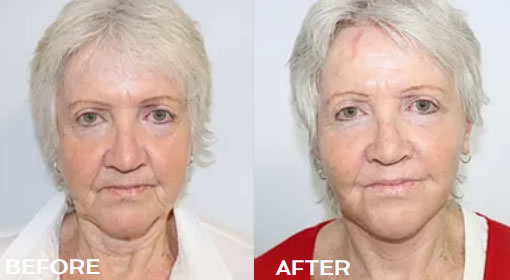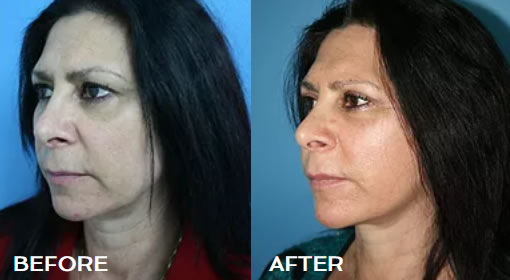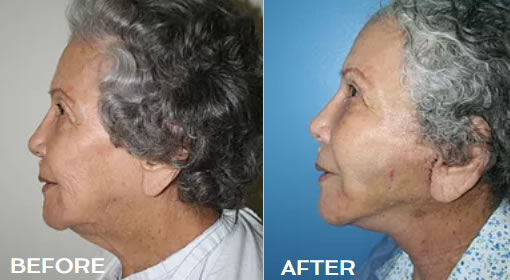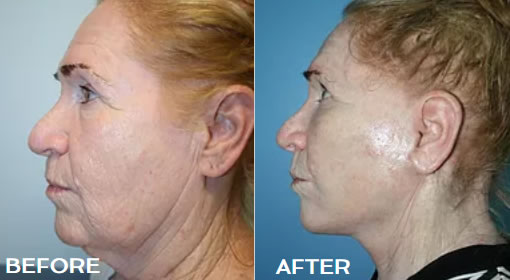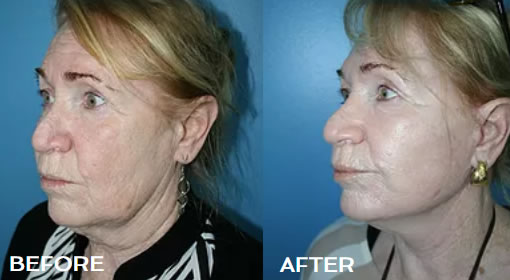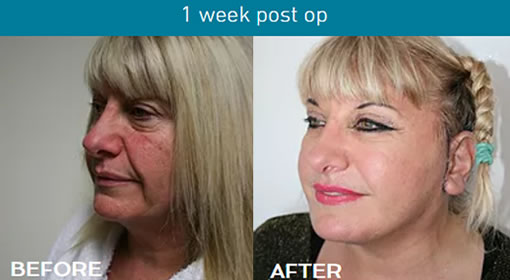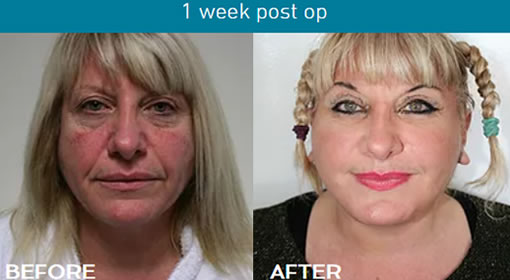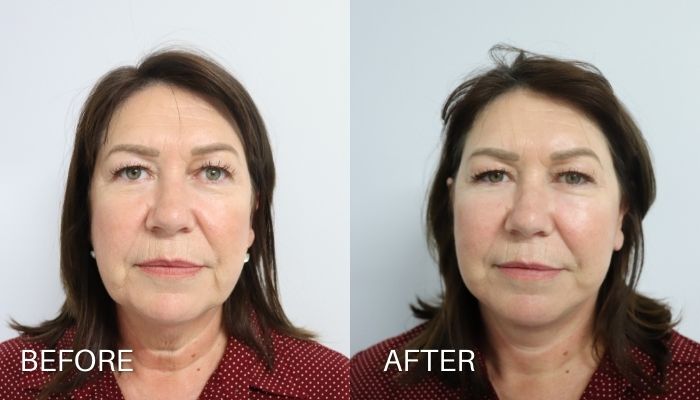As the only surgeon in Australia specialising in both Maxillofacial and Cosmetic Surgery, Dr John McHugh is uniquely qualified to deliver an aesthetically beautiful result.
Typical face lifts stretch skin tighter over the face, which can give a tight, pinched appearance. Dr McHugh’s complementary specialisation in Maxillofacial surgery means that he works with the deeper facial planes and muscular structure. This type of facelift is known as a Deep Plane Facelift and is considered the ‘gold standard’ of face lifts.
View our Frequently Asked Questions below to find out more about facelifts.
Frequently Asked Questions
Most commonly performed on patients in the 40-60 age range, face lifts can also produce great results for people in their 60s, 70s and 80s.
Good candidates for a facelift include healthy men and women with any of the following conditions:
– Deep nasolabial folds-the lines that runs from the corners of the nose to the corners of the mouth
– Sagging skin and deep wrinkles in the cheeks and cheekbone area
– Loss of jawline definition
– Redundant skin, wrinkles, or excess fatty tissue in the neck
Though face lift surgery offers great benefits for many, it should to be approached with extra caution for those with any of the following medical conditions:
– High blood pressure
– Blood-clotting issues
– Problems healing causing excessive scarring
If you have any of these medical conditions, it is important to advise Dr. McHugh during consultation.
A personal consultation with your surgeon is the first step for any patient considering cosmetic surgery. Dr McHugh will assess your physical and emotional health, discuss your aesthetic goals, and address any questions or concerns you may have.
Issues you should be prepared to discuss during consultation with Dr McHugh include:
– All medical conditions, both past and present
– Current medications, including nutritional supplements and herbal remedies
– Past surgeries
– Other treatments you have received
Because significant weight loss after surgery can affect your surgical results, it is also important to discuss any weight loss goals with Dr McHugh during consultation.
Your physical evaluation with Dr McHugh will include an assessment of your bone structure and underlying facial tissues, as well as the thickness, texture and elasticity of your skin and the severity of the wrinkles and folds being addressed. Your hairline will be carefully examined as well to create a plan for discreet incision placement.
For a more complete rejuvenation, Dr McHugh may discuss additional procedures that can be performed along with face lift surgery. Patients frequently combine facelift surgery with:
– Eyelid surgery, to address upper eyelid droop or bags beneath the eyes
– Brow lift, to smooth forehead lines or furrows
– Rhinoplasty (nose reshaping)
– Skin treatments, such as laser and dermabrasion, to improve skin tone and minimise fine wrinkles
There are many variations to the face lift procedure. The technique Dr McHugh uses for your procedure depends upon your individual features and aesthetic goals. Dr McHugh will discuss your options with you during your consultation.
Typically, the incision is hidden in the natural contour of your ear, and extended around the earlobe and into the hairline for easy concealment. A small incision hidden beneath your chin may also be needed.
Using these facial incisions, Dr McHugh will separate the facial skin from the underlying tissues, pulling it back. He will then remove any excess skin and may reposition deeper tissues if needed to improve your facial contour. If necessary, an incision may be made beneath the chin to remove fatty tissue in that area and decrease the appearance of muscle bands in the neck.
Though thousands of people undergo facelifts each year and experience no major complications, the procedure does carry some degree of risk. It is important you be well informed of these risks when considering a facelift.
The discussion of potential risks and complications is one of the most important aspects of patient consultation. During your consultation, Dr McHugh will discuss these potential complications with you, listen to your safety questions, and offer recommendations on how to minimise your risk.
It is important to follow Dr McHugh’s instructions when preparing for surgery to ensure the best possible results. Those instructions may include:
– Refraining from smoking for several weeks before and after surgery
– Avoiding certain medications
– Arranging for help following surgery, such as a ride home and in-home care for the first 24 hours
– Growing your hair to cover your incisions as they heal
For your comfort and convenience, Dr McHugh operates either in his clinic under local anaesthetic with intravenous sedation or under general anaesthetic at various private hospitals.
He will carefully monitor your physical status throughout the operation and during your recovery.
Directly after surgery, you’ll be taken to a recovery area. A bandage may be used around your face to control swelling, and small drainage tubes may be placed beneath the skin to prevent the accumulation of fluids. Though post-surgical discomfort is typically minimal, your pain can be controlled with medication.
Though everyone heals at a different pace, the following is typical of recovery from a brow lift:
The day of face lift surgery
– You can expect to experience some bruising and swelling which can be reduced by keeping your head elevated
The first week
– Bandages will be removed
– Bathing and showering will be permitted
– Stitches will be removed or dissolve
– Applying makeup to hide bruising and discoloration
– Swelling will reach its peak, then begin to subside
– Light activity will be permitted
– Sleeping with elevated head will continue to aid in the reduction of swelling
Within two weeks
– Most bruising will subside
– Normal activities and non-strenuous work will be permitted
After several weeks
– Swelling will continue to subside
– Numbness will diminish greatly; though some may persist for several months
– Exercise may be resumed
Direct sunlight should be avoided throughout the entire healing process. Sunblock should be used long-term to protect your skin.
Most people who undergo face lift surgery are very pleased with their results. The healing, however, will take some time, so you may not see the final results of your surgery for several months.
How long your face lift results will last depends upon a number of factors, including your genetics and the lifestyle you lead. Though a facelift cannot stop the ageing process, patients are typically very happy with their facial appearance for many years following their procedure.
Additional improvements, such as a neck lift or brow lift, can be performed at a later time to maintain a more youthful look.
Follow-up visits are important to answer any questions you may have and monitor your healing process.
Your first post-operative visit will be scheduled after the initial healing period, during the first few days after surgery.
In the following months, Dr McHugh may ask you to return for periodic checkups.
Keeping these appointments is important to assessing your long-term results and address any questions or concerns you may have.
Facelift Gallery
Before-and-after photos of face lifts performed by Dr McHugh

His dual specialisations enable him to deliver excellence in surgical results, with an eye for aesthetic beauty.
With over 20 years of experience as a surgeon in the private sector and performing international aid work as a Surgeon Commander with the Royal Australian Navy, you can have confidence that Dr McHugh is uniquely qualified and trusted to deliver the results you seek.



